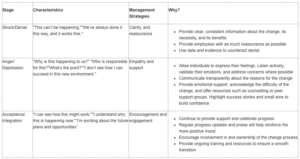We often speak about change projects being handled compassionately and studies show that change projects that are handled in a compassionate way are more successful.
There are the obvious business-related benefits to handling change projects compassionately, but the need for compassion comes from the emotional and psychological impact on the workforce being affected by the projects.
The Kubler-Ross Grief Curve was originally developed by Elisabeth Kubler-Ross to describe the stages of grief experienced by terminally ill patients. Since it was developed in the 1960s it has been widely adapted for understanding emotional responses to any dramatic life changing situation including organisational change projects. When applied to change projects, the curve helps in understanding how individuals typically react to significant changes, providing a framework to manage these responses effectively.
The original five stages of grief (denial, anger, bargaining, depression and acceptance) have adapted over the years and there are numerous versions of the curve that exist. Below is one example:

However, the majority of them are consistent in their use of the basic emotions. These can be grouped into three stages. Below we take a detailed look at the stages of the Kubler-Ross Curve in the context of change projects:
Stage 1: Shock and Denial
The first reaction to most change situations is shock. This can result in a temporary slowdown and loss of productivity. An individual’s performance can dip, with those who are usually clear and decisive seeking more reassurance.
This stage can be made worse by:
- A lack of information
- Fear of the unknown
After the initial shock has subsided it is common for this to be replaced by denial, with individuals focusing on the past and questioning why things have to change.
Common feelings in this stage are:
- Being comfortable with the status quo
- Feeling threatened
- Fear of failure
Those individuals who have not experienced major change can be affected the most by this stage. Many will convince themselves that the change isn’t going to happen or that it won’t affect them. In this stage individuals will often continue as normal, ignoring communications about the changes, providing excuses to avoid taking part or engaging in planning and consultation activities.
Stage 2: Anger and depression
As the initial shock and denial in stage one subsides this can be replaced by anger. Individuals may seek out a ‘scapegoat’ usually the organisation, group or an individual that they can make responsible and channel their anger and frustrations towards.
This stage can be associated with:
- Suspicion
- Skepticism
- Frustration
The lowest point of the curve comes when the anger and frustration wears off and the realisation that the change is genuine hits. This results in individuals feeling depressed; staff morale will be low at this stage, with self-doubt and anxiety peaking.
Common signs of this stage can be:
- Apathy
- Isolation
- Remoteness
Performance is often at its lowest at this stage and there is a tendency for individuals to fixate on small issues and problems
Stage 3: Acceptance and integration
Hopefully, once stage 2 emotions have passed, individuals will move into a more optimistic and enthusiastic mood, where they accept that the change is inevitable and begin to work with the organisation to achieve the aims of the change project, rather than against it. Some of the signs of this stage can be:
- Excitement (particularly at new opportunities)
- Relief (feelings that they have ‘survived’ the change)
- Impatience for the changes to be completed
The final steps invite integration, where the focus is firmly on the future. During the initial part of this stage, energy and productivity can still remain low but will begin to show signs of recovery. Individuals will usually be curious about the possibilities and opportunities within this stage.
Management responses
The change curve is useful when managing change projects; knowing where a team or an individual is on the curve can help with decisions as to when and how information is communicated and what management responses are best suited for each stage.
Of course, communication and compassion are integral at all stages of a successful change project. However, we have set out some other management responses that may be beneficial at different stages of the change curve.

Additional Considerations
Communication: Effective and ongoing communication is crucial at all stages. However, consideration should be given to tailoring messages to address the specific concerns and emotional states of employees at each stage.
Support Systems: Establish support systems, such as change champions or mentors, to help individuals navigate through the stages of the grief curve, particularly in stages 1 and 2.
Flexibility: Understand that not everyone will move through the stages at the same pace; it is not uncommon for individuals to also ‘relapse’ and move back into earlier stages, particularly if communication is not handled correctly. Be flexible and patient, offering additional support where needed.
Feedback Loops: Create mechanisms for continuous feedback to monitor employee responses and adjust strategies accordingly.
Each person will react to change differently; not all will experience every phase of the change curve and some will spend more time in one stage than the other. Each individual’s experience of a change process will be different, even for those who are experiencing the same process at the same time. By understanding and anticipating the emotional responses outlined in the Kubler-Ross Grief Curve, leaders can better support their teams through change projects, ensuring a smoother transition and higher likelihood of successful implementation.
If you think your team would benefit from talking about a workplace Change Project, please get in touch to find out more.
Author: Kate Woosnam, Lead Associate




